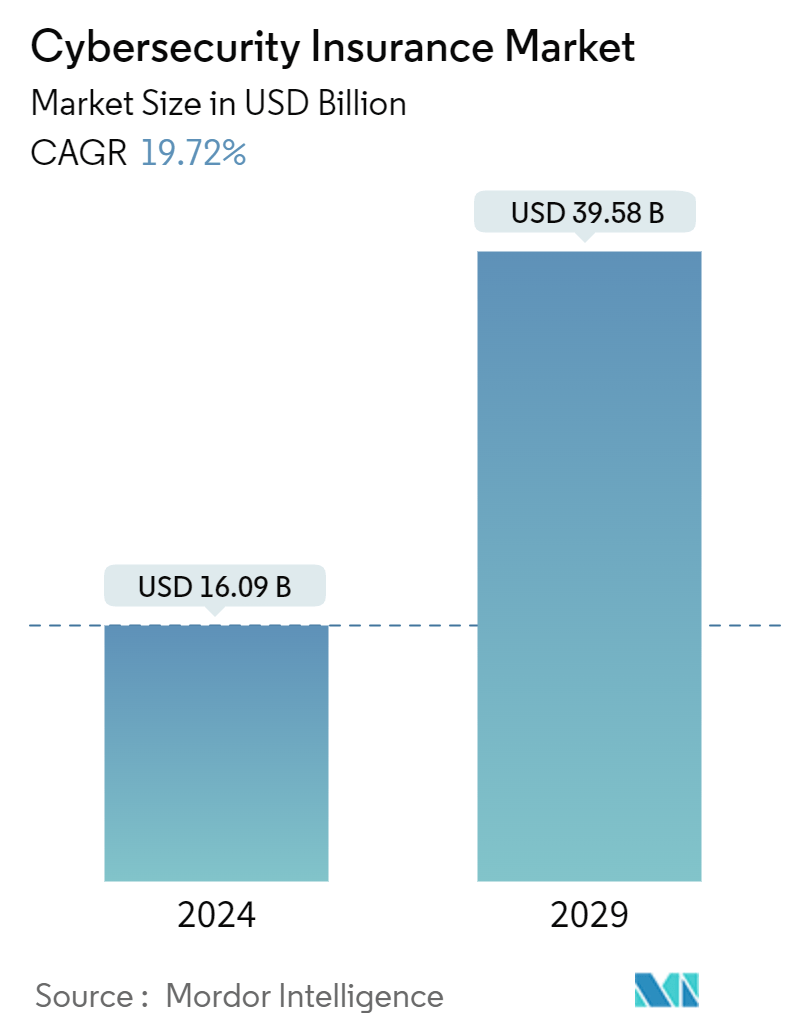Market Size of Cybersecurity Insurance Industry

| Study Period | 2019 - 2029 |
| Market Size (2024) | USD 16.09 Billion |
| Market Size (2029) | USD 39.58 Billion |
| CAGR (2024 - 2029) | 19.72 % |
| Fastest Growing Market | Asia Pacific |
| Largest Market | North America |
Major Players
*Disclaimer: Major Players sorted in no particular order |
Cybersecurity Insurance Market Analysis
The Cybersecurity Insurance Market size is estimated at USD 16.09 billion in 2024, and is expected to reach USD 39.58 billion by 2029, growing at a CAGR of 19.72% during the forecast period (2024-2029).
Increasing digitalization and rapid development in the cloud, Big Data, IoT, and artificial intelligence (AI) in business and society and the growing connectivity of everything have increased the workload of already strained IT teams.
- IT advances, communication technologies, and the smart energy grid are changing the landscape of all every country's critical infrastructure and business networks. However, with rapidly evolving technology comes rapidly advancing threats. Personal data is valuable, which prompts cybercriminals to commit crimes, where personal information will be sold on the dark web, like a credit card number, identity, medical records, etc. It is among the few factors that have led to an increased demand for cybersecurity.
- Cloud computing is one of the most rapidly growing recent technologies, eliminating the traditional boundaries of IT, creating new markets, spurring the mobility trend, and enabling advances in unified communications. Various tech stakeholders and organizations are turning to new insurance models to mitigate the risks of storing sensitive data in the modern cybersecurity landscape.
- As the cybersecurity insurance space continues to mature, insurers will consider a broader range of security controls and technologies in their assessments. Hence, the sensitivity level of an organization's data and its ability to adequately obscure it will play a key role in determining the overall risk, which is driving the adoption of new technologies like micro shading. Microsharding technology breaks data into fragments that can be as small as single-digit bytes before polluting and distributing shards to multiple locations to reduce the attack surface and eliminate data sensitivity.
- Cyber insurance policies and businesses cover a wide range of risks, and insurers do not always agree on which loss events are covered. Cyber events have characteristics that make it challenging to write comprehensive policies, such as limited loss history, the unreliability of past data when predicting future events, and the possibility of a large-scale attack with highly correlated losses across companies and industries.
- Furthermore, insurers are still working on precise and accurate criteria for cyberattacks and the impact of new technologies like the Internet of Things. Cyber insurance coverage could be ineffective and expose firms to considerable damage if big cyberattacks occur without well-defined dangers and an understanding of how they affect insurers.
Cybersecurity Insurance Industry Segmentation
Cybersecurity insurance is a contract that an individual or entity can purchase to help reduce the financial risks associated with an online business. The insurance policy transfers some of the risks to the insurer in exchange for a monthly or quarterly fee. Many companies purchase cybersecurity insurance policies to cover extra expenditures that could result from the physical destruction or theft of digital assets. Such spending typically includes the cost of notifying customers that a security breach has been incurred, as well as the cost of regulatory compliance fines.
The cybersecurity insurance market is segmented by size of organization (small and medium enterprises (SMEs) and large enterprises), end-user industry (healthcare, retail, BFSI, IT and telecom, and manufacturing), and geography (North America, Europe, Asia Pacific, Rest of the World).
The market sizes and forecasts are provided in terms of value (USD) for all the above segments.
| Organization Size | |
| Small and Medium Enterprises (SMEs) | |
| Large Enterprises |
| End-user Industry | |
| Healthcare | |
| Retail | |
| BFSI | |
| IT and Telecom | |
| Manufacturing | |
| Other End-user Industries |
| Geography | |||||||
| |||||||
| |||||||
| |||||||
| Latin America | |||||||
| Middle East and Africa |
Cybersecurity Insurance Market Size Summary
The cybersecurity insurance market is experiencing significant growth, driven by the increasing digitalization and the rapid advancement of technologies such as cloud computing, Big Data, IoT, and artificial intelligence. These developments have heightened the demand for cybersecurity insurance as businesses seek to protect sensitive data from evolving cyber threats. The market is characterized by a growing need for innovative insurance models to mitigate risks associated with data storage and connectivity. As organizations face challenges in defining comprehensive cyber insurance policies due to the unpredictable nature of cyberattacks, the adoption of advanced technologies like microsharding is becoming crucial in reducing data sensitivity and attack surfaces. The BFSI sector, in particular, is a major contributor to the market's expansion, as it grapples with frequent data breaches and cyberattacks, necessitating robust cybersecurity measures to safeguard financial information and maintain customer trust.
The United States stands out as a leading market for cybersecurity insurance, driven by the high incidence of cyberattacks and the proliferation of connected devices. The region's significant number of data breaches has prompted organizations across various industries to invest in cybersecurity insurance to mitigate potential losses. Government initiatives, such as the establishment of the Cybersecurity and Infrastructure Security Agency (CISA), further bolster the market by providing essential cybersecurity tools and services. The market is moderately consolidated, with key players investing in technological innovations and strategic partnerships to enhance their offerings. Recent collaborations, such as CloudCover Re's partnership with Hylant Global Captive Solutions, highlight the industry's focus on providing cost-effective and comprehensive cyber insurance solutions. These developments underscore the growing importance of cybersecurity insurance in safeguarding businesses against the financial repercussions of cyber threats.
Cybersecurity Insurance Market Size - Table of Contents
-
1. MARKET INSIGHTS
-
1.1 Market Overview
-
1.2 Industry Value Chain Analysis
-
1.3 Industry Attractiveness - Porter's Five Forces Analysis
-
1.3.1 Threat of New Entrants
-
1.3.2 Bargaining Power of Buyers
-
1.3.3 Bargaining Power of Suppliers
-
1.3.4 Threat of Substitute Products
-
1.3.5 Intensity of Competitive Rivalry
-
-
1.4 Industry Guidelines and Policies
-
1.5 Assessment of the Impact of COVID-19 on the Market
-
-
2. MARKET SEGMENTATION
-
2.1 Organization Size
-
2.1.1 Small and Medium Enterprises (SMEs)
-
2.1.2 Large Enterprises
-
-
2.2 End-user Industry
-
2.2.1 Healthcare
-
2.2.2 Retail
-
2.2.3 BFSI
-
2.2.4 IT and Telecom
-
2.2.5 Manufacturing
-
2.2.6 Other End-user Industries
-
-
2.3 Geography
-
2.3.1 North America
-
2.3.1.1 United States
-
2.3.1.2 Canada
-
-
2.3.2 Europe
-
2.3.2.1 Germany
-
2.3.2.2 United Kingdom
-
2.3.2.3 France
-
-
2.3.3 Asia
-
2.3.3.1 India
-
2.3.3.2 China
-
2.3.3.3 Japan
-
2.3.3.4 Singapore
-
2.3.3.5 Australia and New Zealand
-
-
2.3.4 Latin America
-
2.3.5 Middle East and Africa
-
-
Cybersecurity Insurance Market Size FAQs
How big is the Cybersecurity Insurance Market?
The Cybersecurity Insurance Market size is expected to reach USD 16.09 billion in 2024 and grow at a CAGR of 19.72% to reach USD 39.58 billion by 2029.
What is the current Cybersecurity Insurance Market size?
In 2024, the Cybersecurity Insurance Market size is expected to reach USD 16.09 billion.

